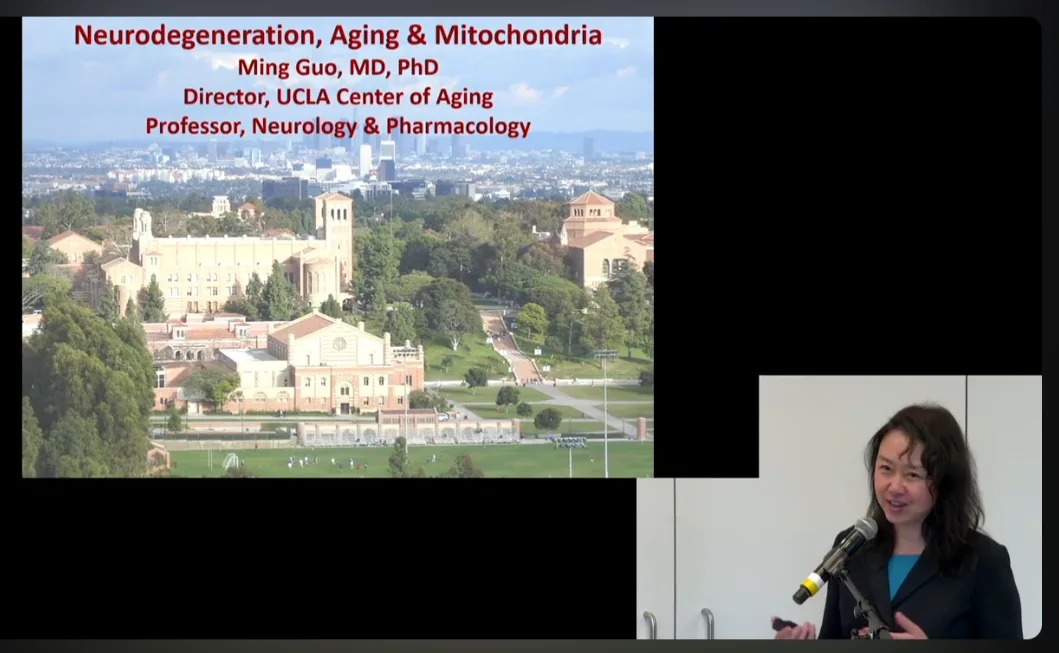Neurodegeneration, Aging & Mitochondria by Dr. Ming Guo
Published July 2025
Dr. Ming Guo, a physician-scientist specializing in neurological diseases and director of an aging center, presented groundbreaking research on the intersection of neurodegeneration, aging, and mitochondrial function at the Blue Oak NX event held at the UCLA Mathias Botanical Gardens, Los Angeles, May 13, 2025.
NOTE: This article is a synopsis of the key highlights of Dr. Ming Guo’s talk
Core Research Framework
Dr. Guo outlined two complementary strategies for addressing neurodegenerative diseases that currently affect more than a third of the population, with no available cures.
- The first approach focuses on individual diseases like Alzheimer’s, Parkinson’s, ALS, and frontotemporal dementia.
- The second, more revolutionary strategy targets aging itself, based on the principle that delaying aging could simultaneously delay multiple chronic diseases.
Breakthrough Discoveries in Parkinson's Disease
Pink1 and Parkin Pathway
Dr. Guo was part of the collaborative research effort that made the groundbreaking 2006 discovery showing that Pink1 and Parkin function together in a pathway controlling mitochondrial integrity and quality.
Mutations in these genes lead to recessive forms of Parkinson’s disease, revealing that the pathology extends far beyond the traditional focus on dopaminergic neurons in the midbrain.
Beyond Dopamine Replacement
The presentation challenged current treatment paradigms by demonstrating that Parkinson’s involves much more than dopamine deficiency.
Patients experience both motor symptoms (tremor, slow movement, rigidity, balance problems) and debilitating non-motor symptoms (dementia, cognitive impairment, depression, psychosis, sleep disorders) that don’t respond to dopamine replacement therapy.
Mitochondrial Dynamics
Dr. Guo explained how mitochondrial morphology is maintained through dynamic balance between fusion and fission processes.
In Pink1 and Parkin mutations, this balance is disrupted, leading to pronounced mitochondrial defects.
Her research identified multiple molecular suppressors that can reverse these pathological features in animal models.
Multi-System Disease Research
The presentation detailed work on a mutation causing inclusion body myopathy, Paget’s disease with frontotemporal dementia (FTD), sporadic ALS, and ataxia, demonstrating how single genetic defects can manifest as multi-system diseases affecting brain, muscle, and bone.
Using novel compounds in animal models, the team successfully normalized mitochondrial morphology and restored densely packed cristae structure.
Revolutionary Aging Research
The Aging-Disease Connection
Dr. Guo presented compelling statistics showing that one in three seniors dies with Alzheimer’s or related dementia, with disease prevalence doubling every five years.
This aging dependency suggests that stopping or reversing aging could cut disease burden by half, a potentially transformative impact.
Mitochondrial DNA and Aging
The research revealed that aging involves accumulation of damaged mitochondrial DNA in critical tissues including brain, muscle, heart, and pancreas.
As cells accumulate mutated mitochondrial DNA beyond a certain threshold, cellular dysfunction and death occur, forming a foundation of the aging process.
A more detailed read on mitochondria and aging on this blog.
Selective Elimination Technology
In collaboration with California Institute of Technology (CalTech), Pasadena, California, Dr. Guo’s team developed tools that can selectively eliminate up to 95% of mutant mitochondrial DNA while preserving healthy mitochondria.
This represents a novel form of mitochondrial quality control that could address both aging and mitochondrial diseases.
Clinical and Research Implications
Bridging Rare and Common Diseases
The presentation elegantly connected rare mitochondrial diseases (affecting 1 in 5,000 people) with common age-related conditions.
Children with mitochondrial diseases experience cognitive disabilities, strokes, seizures, sensory problems, muscle weakness, and diabetes—symptoms that mirror aspects of aging-related decline.
Collaborative Research Platform
Dr. Guo described ongoing collaborative efforts with UCLA and Caltech teams to develop human culture systems carrying disease-relevant mutations.
These platforms enable genome-wide and compound screens to identify factors that can remove cellular signatures of aging.
Scientific Innovation
The research represents a paradigm shift from treating individual diseases to addressing fundamental aging mechanisms.
By developing tools that can selectively target damaged mitochondrial DNA while preserving healthy organelles, the work opens possibilities for interventions that could simultaneously address multiple age-related conditions.
Future Directions
The presentation concluded with acknowledgment of the collaborative nature of this cutting-edge research, involving teams across multiple institutions. The development of screening platforms using human culture systems suggests the field is moving toward systematic identification of anti-aging interventions targeting mitochondrial dysfunction.
Dr. Guo’s research offers hope that understanding and manipulating mitochondrial quality control mechanisms could provide therapeutic approaches for both rare genetic diseases and common age-related neurodegeneration, potentially transforming how we approach human healthspan and longevity.
Watch the video.



